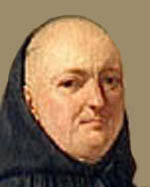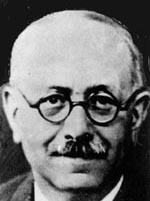Gallery of Philologists
Jean Mabillon
23 November 1632 - 27 December 1707
Mabillon was born in Saint-Pierremont in Champagne, France, the son and fifth child of Estienne Mabillon (who died in 1692 at age 104) and Jeanne Guérin. The father was a peasant, but the mother had a certain background; she was descended, through her own mother's family, from a branch of the seigneurs of Saint-Pierremont. Jean was a bright and agreeable child, easily surpassing his schoolfellows. At age 9 he was sent to his uncle, also named Jean Mabillon, who was then the parish priest at Neufville, for instruction in the rudiments of learning; after three years, the uncle also made it possible for young Jean to continue his studies at the Collège des Bons Enfants in Reims. While there, he lived as a pupil and also as a servant (the combination will surprise no one who has read the Dharma Sutras, or Gwandz 59) in the house of Clément Boucher, Canon of the Cathedral, who in turn, after three years, recommended him for the next step: the diocesan seminary. After three years at the seminary, he resigned, not to take the next step in the path, but to renounce the path: the "scandalous conduct" and death of the uncle who had set him on that path had soured his devotion to the priesthood.
After an interim month, in 1653 Mabillon became a postulant at the Maurist Abbey of Saint Remi, and after a year's novitiate, his profession was accepted on 6 September 1654. So great was his devotion to study, and so strict was his observance of the monastic regimen, that his superiors entrusted him with the direction of the novices, but this new responsibility overtaxed his strength, and in 1656, after he had reached a condition of mind where he could no longer recite his Office, his superiors sent him for rest, first to Nogent and then, in July 1658, to the Abbey of Corbie, where he studied antiquities and filled in succession the offices of porter, depositarius, and cellerer. He was ordained at Amiens in 1660. In 1663, with his health entirely restored, he was transferred to the Abbey of St-Denis, where he became treasurer. His great intellectual gifts had however not escaped notice, and a year later, at the request of Dom D'Achéry, he was transferred to the Abbey of St-Germain-des-Prés in Paris, where he was to live for the rest of his life.
In Saint-Germain, he was at last among congenial company, and results followed quickly. D'Achéry was the custodian of the Abbey's well-stocked library. Every week, on Sundays after Vespers, there met in his room a group of men who were already scholars of reputation - Charles du Fresne, Sieur du Cange, Etienne Baluze, d'Herbelot, Cotelier, Renaudot, Fleury, Lamy, Pagi, and Louis-Sébastien Le Nain de Tillemont. Mabillon soon took a prominent place among them. D'Achéry had asked for him to help him in his projected "Lives of the Benedictine Saints," but the first task he undertook was editing the works of St. Bernard. This was published within three years, in 1667, and was recognized as a masterly accomplishment. Meanwhile Mabillon had been arranging the materials already brought together by D'Achéry. The first volume of the "Acta Sanctorum OSB" was published in 1668, a second volume in 1669, and the third in 1672. The Acta being thus completed, Mabillon made a "literary journey" to Flanders, in search of documents and materials for his work, and in 1675 he published the first of four volumes of "Vetera Analecta" in which he collected the fruit of his travels and some shorter works of historical importance. Mabillon had now joined the ranks of Renaissance philology, and was soldiering in its front lines; its lines of discovery.
He had however not left the Acta behind him. Faith and reason do not comfortably mix at any time, and the unquestionably devout Mabillon had been using Reason as a broom to tidy in the House of Faith. The very scholarly conscientiousness of his work on the Benedictine Saints had scandalized some of the other monks, and in 1677 a petition violently attacking it was presented to the general chapter of the congregation, demanding its suppression and an apology from its author. Mabillon defended himself with such humility, and such learning, that the opposition was silenced, and he was encouraged to continue.
Now came greatness. Back in April 1675, Daniel Papebroch had written a "Propylaeum Antiquarium", a first attempt to formulate rules for distinguishing spurious and genuine documents. As examples of spurious documents, he had cited some monastic charters in the Abbey of St-Denis. Mabillon was appointed to write a defense of these documents, and his defense, finally published in 1681 as De Re Diplomatica Libri Sex (Six Books on the Monastic Charters), laying down the principles of document criticism. This work was unlike anything he had done before; it marked him as an original and acute scholarly mind. Papebroch confessed himself confuted, and the admiration of the learned knew no bounds. Colbert offered Mabillion a pension of 2000 livres, which Mabillon declined, while soliciting Colbert's continued protection for his monastery. Documents now became his agenda: in 1682 Mabillon was sent by Colbert into Burgundy to examine certain ancient documents relating to the Royal house. In 1683 he was sent to Switzerland and Germany with Dom Michel Germain, at the King's expense, in search of materials for the history of the Church or that of France. Colbert died while this expedition was in progress, but was succeeded as Minister by Le Tellier, Archbishop of Reims, another admirer of Mabillon. At the suggestion of Le Tellier, the King in 1685 sent Mabillon on a tour through the libraries of Italy to acquire books and manuscripts for the Royal Library, a search which yielded more than 3000 rare items.
Soon after his return another controversy broke out, this one with De Rancé, Abbot of La Trappe, who had denied that it was lawful for monks to devote themselves to study rather than to manual labor. Mabillon's "Traitê des Études Monastiques" (1691) defended monastic learning, and laid down guidelines for its practice. De Rancé replied, and Mabillon was publish further "Réflexions sur la Réponse de M. l'Abbé de la Trappe" (1692) . Cardinal le Camus halted what would have been an ongoing exchange, and the general opinion seems to have been that both parties were in substantial agreement: Mabillon exemplifying devotion combined with prodigious learning, and de Rancé showing by his writings that learning was not incompatible with devotion to monastic strictness.
The next storm broke in Rome, where under the name Eusebius Romanus, Mabillon had published a protest against the superstitious veneration of the relics of "unknown saints" from the Roman catacombs; his rational broom was again at work in the House of Faith. The work was denounced to the Holy Office, and Mabillon was compelled to explain and modify certain passages.
In 1700 the Maurists, in spite at the difficulties arising from the current controversies on Jansenism (see under Pascal), had determined to publish a critical edition of St. Augustine. To the last volume of this edition Mabillon was required to furnish a preface, defending the methods and critical conclusions of its editors. His first draft was submitted to various critics, rewritten, and sent to Bossuet for his opinion. Bossuet amended it, and returned it to Mabillon for a final rewrite. The result is the "Preface" of the eleventh volume as we now have it. Expecting controversy, Mabillon retired to Normandy. Controversy did eventuate, and extremists charged the moderates with heresy, but the Pope supported the Maurists and silenced the tumult.
The King of France did more than this. In 1701 he appointed Mabillon one of the founding members of the Académie des Inscriptions et Belles-Lettres, an institution which still exists and remains important at the present time. A certain Germon attempted to undermine this success by disproving Mabillon's theory of document authenticity; this provoked a reply from Mabillon in the form of a 1704 Supplementum to his original 1681 work. Finis coronat opus.
In 1707, Mabillon fell ill while on his way to Chelles. He was carried back to Paris. After three weeks' illness, he passed away after having heard Mass and received communion at midnight on 27 December. He was buried in the Lady Chapel at St-Germain. At the Revolution in 1798, when the Lady chapel of St-Germain was destroyed, Mabillon's tomb was relocated in the garden of the Musee des Petits-Augustins. At the Restoration, it was moved back to St-Germain, where it still remains behind the high altar.
Philology is the prepartory science of history; it makes the texts safe for the historians to use in putting together the past. We might cite one historian's view of the importance of Mabillon. This is from Marc Bloch's enduring treatise, The Craft of the Historian:
True progress was first made on the day when doubt was made, as Volney said, "the examiner;" or in other words, when objective rules were little by little elaborated which made it possible to separate the false from the true. The Jesuit Papebroeck, in whom the reading of the Lives of the Saints had inspired an unswerving distrust toward the entire heritage of the Middle Ages, considered all the Merovingian charters (diplomata) preserved in the monasteries to be forgeries. No, replied Mabillon in effect, there are unarguably some charters which are wholly forged, or altered, or interpolated. There are also authentic ones, and here is how it is possible to distinguish them from the others. In that year - 1681, the year of the publication of De Re Diplomatica, truly a great date in the history of the human spirit - the criticical approach to archival documents was definitively established.
Mabillon's method was essentially paleographical: it relied on having before one the actual manuscript of a charter, then on closely examining the peculiarities of its handwriting, and finally on collating these with all other available specimens of monastic handwriting, to arrive at a picture of the evolution, not just of handwriting as such, but of handwriting as it had evolved in different ways in the various monastic centers of Europe. The goal is to set up a framework of Before and After, against the details of which an individual manuscript can be compared, and against the sequence of which that manuscript can be placed.
The counterpart, when actual manuscripts are not available, is an ordered lexicon, giving the earliest appearances of words and especially technical terms in the language, and leading to greater precision in the detection of anachronisms. It was such a lexicon, in his case one kept in memory as one aspect of his enormous erudition in the relevant literature, which Lorenzo Valla had in part relied on in his exposure of the infamous Donation of Constantine. Mabillon is here reducing the generalized but diffuse knowledge of one man to the status of a system, even a tool, that can be learned and applied by other men.
Ante Agamemnonum. There had been learned men before Mabillon, and there would be others after. It is the creation of the tool that is the decisive step forward in the history of philology. We honor Mabillon not so much for his learning as for that step beyond learning.
2 Oct 2006 / Contact The Project / Exit to Gallery Index Page

